Best Travel Zooms for your Canon DSLR: 8 fantastic choices for serious shooters on the go
posted Wednesday, August 3, 2016 at 4:28 PM EDT

Vacation time! You're about to set off on the trip of a lifetime (or maybe just a weekend when you need to travel light): You want to bring your Canon DSLR along for great photos, but would like to keep bulk and weight to a minimum. What to do? It turns out there are some great options for travel lenses for your Canon camera.
The lenses that experienced photographers actually take with them when they're traveling or on vacation are as varied as their individual tastes and photographic styles. If I were a Canon shooter going on a once-in-a-lifetime trek and had unlimited funds, a creative passion, and a strong back, I'd pack the following 3-piece dream outfit:
- A Canon 5DS R body (street price: $2,699, weight 1 pound 13.8 ounces),
- A Canon 24-70mm f/2.8 L II USM zoom (street price: $1749, weight 1 pound 12.4 ounces),
- A Canon 70-200mm f/2.8L IS II USM zoom (street price: $1,949, weight 3 pounds 4.5 ounces).
That's a grand total of $6,397 and a combined weight of 6 pounds, 13.7 ounces, not including my camera bag, assorted accessories, and the inevitable travel tripod! For most of us, though, there are more practical, portable, and considerably less expensive alternatives that will let us have an excellent adventure, yet still return home with a portfolio of images we can be proud of.

Here are our carefully considered picks -- based on our actual hands-on experience -- in three popular categories aimed primarily at APS-C-format Canon DSLR owners. All offer noticeably above-average performance, convenience, and value in their respective classes. And half of them, as duly noted, will work for full-frame cameras, too. We have 8 great but rather different Canon travel lens options for you; let's break them down by category...
Long range all-in-one travel zooms for Canon APS-C-format DSLRs
The upsides
Compact wide-angle-to-telephoto zooms are often referred to as "vacation lenses" because they offer supreme framing flexibility in a relatively compact package. This lets you cover practically any subject from expansive vistas, to street shots, to details of landmarks, and even macro close-ups, without having to change lenses. Indeed, this makes them ideal for shooting in dusty or windy conditions where changing lenses risks getting dust on the sensor and dust spots on all your photos. Their ultra-wide zoom ranges also allow you to react instantly to changing circumstances by simply turning the zoom ring, which can be a great advantage when shooting pictures on the fly.
While all-in-one zooms are physically larger than normal zooms, they're often reasonably lightweight and well balanced on the camera thanks to their moderate variable maximum apertures of f/3.5-5.6 or f/3.5-6.3, for example. Since today's DSLRs are capable of delivering excellent image quality at elevated sensitivity ratings -- ISO 1600 and even higher -- shooting at moderate apertures like f/6.3 or f/8 is seldom a problem. And it's significant that all 3 lenses we've chosen in this category feature built-in optical image stabilization (called IS, VC, OS by different manufacturers) that provides a 3-4-(8-16x) advantage in reducing the effects of camera shake at slower shutter speeds, crucial when shooting handheld at long telephoto settings.
The downsides
Long-range, wide-to-telephoto zooms generally can't deliver uniformly excellent image quality comparable to that of single focal length (prime) lenses or moderate-zoom-range pro-caliber zooms (such as the Canon L series) over their entire focal-length ranges, especially at their brightest apertures. Typically their image quality falls off as they approach the long telephoto end, but sometimes image quality gaps occur at the moderate wide-angle or normal focal length settings. Vignetting can also be an issue. In most cases, stopping down 2-3 stops will produce a satisfying boost in imaging performance, and many users will be quite pleased with the overall performance of the lenses on our short list.
If you're super-critical and demand something close to optical perfection, though, please direct your attention to the other two lens categories below.
1) Canon EF-S 18-200mm f/3.5-5.6 IS
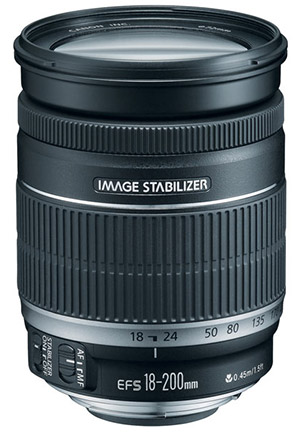
This well established EF-S mount lens provides an equivalent focal length range of 29-320mm for APS-C Canon DSLRs and minimizes chromatic aberrations and enhances overall image quality thanks to special UD and aspheric lens elements. It includes Canon's Image Stabilization (IS) technology, allowing the use of shutter speeds up to 4 stops slower while controlling the effects of handheld camera shake. (For instance, where you'd normally need to use a shutter speed of 1/320 second at the telephoto end, you'll instead be able to shoot as slow as 1/20 second and still get reasonably sharp results.) Other features: a zoom lock to prevent barrel creep (the lens slowly extending when the camera is hanging from its neck strap), and Super Spectra Coating to minimize ghosting and flare.
Users say:
The overwhelming majority of user reviews of this lens are very positive, describing it as a great all-purpose walk-around lens that delivers good overall performance and fast AF even without a more advanced USM motor. They praised its versatility, light weight, sturdy barrel, good detail rendition, and high value, stating that it was worth the extra money compared to less expensive alternatives. A few users noted that its performance does not equal shorter-range Canon zooms, and that it can give images a slight yellowish cast, albeit one that's easy to correct in Photoshop. One very experienced Canon shooter was delighted that "it keeps up" with his high-end L lenses and saves time in lens changes. He gave it a 9 out of 10 rating.
Bottom line:
Somewhat better imaging performance than the average vacation lens, this Canon travel zoom is very compact and gives impressive results when stopped down one or two stops. It's a little pricey, but this is a great choice for a Canon travel zoom if you only want to bring one lens.
Buy Now: $699 -- Amazon • Adorama • B&H
2) Tamron 18-270mm f/3.5-6.3 Si II VC PZD
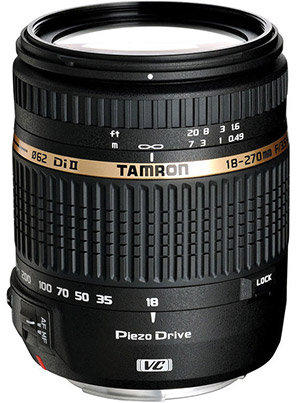
Tamron's classic travel zoom for APS-C-format Canons covers an impressive 15X zoom range equivalent to 29-432mm; incorporates a PZD (Piezo Drive) ultrasonic motor to reduce size while providing quieter, faster AF; employs Tamron's proprietary VC (Vibration Compensation) image stabilization system to minimize the effects of camera shake; and focuses down to an impressive 19.3 inches at all focal lengths. (This is not only a great travel zoom, but it can also serve as a macro lens as well.) It includes 3 hybrid aspheric lens elements and two Low Dispersion (LD) elements to correct axial and lateral chromatic aberrations, and delivers well-balanced performance that falls off only at the widest apertures and longest focal lengths, where stopping down may be necessary to achieve sharper images, especially at the edges.
Users say:
The majority of user reviews fall into very good and good grading categories, with owners praising the quiet AF, excellent color rendition, VC image stabilization, and commendable overall sharpness. Some users noted that the lens was sharper in the mid range than at the telephoto end, noted some flare with brightly lit subjects, complained that the rubber on the zoom ring became loose after prolonged use, noted that it had no full-time manual focus override, and observed some distortion at the wide-angle settings. Most users described it as a perfect travel lens that delivered clear pictures and was easy to use, and they were delighted that it eliminated the need to change lenses when traveling.
Bottom line:
If you're looking for an all-in-one zoom and your priorities are extra reach at the telephoto end in a compact, convenient, affordably priced package this lens is definitely worth checking out. On top of that, its close-focusing capability is an enticing asset. Super-critical users that shoot mostly at the long telephoto end should probably look elsewhere, though.
Buy Now: $349 -- Adorama • B&H
3) Sigma 18-300mm f/3.5-6.3 DC MACRO OS HSM Contemporary
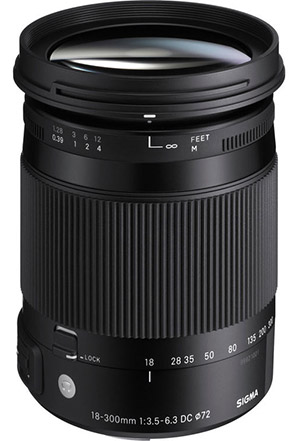
Sigma's newly designed, longer-reaching 16.7X all-in-one travel zoom offers an impressive 29-480mm equivalent range for APS-C cameras. To achieve a high level of aberration correction over such a wide range, it incorporates one Super Low Dispersion (SLD) element and 4 FLD (fluorite equivalent) elements, and it has Sigma's built-in Optical Stabilization (OS) that's said to provide a 4-stop advantage in minimizing the effects of camera shake when shooting handheld. Other features: Super Multi-Layer coating on all elements to reduce flare and ghosting and enhance contrast, extended close-focus capability down to a maximum magnification ratio of 1:3 (1:2 with optional AML72-01 close-up lens).
Users say:
Most user evaluations fall into the Very Good category, above average for a lens of this type. Typical comments praised the nice build quality (if a bit on the heavy side for some) as well as its sheer versatility with a wide range of focal lengths. Some owners pointed out that the lens not as sharp as prime lenses, but found it acceptably sharp overall, with its minor shortcomings easily corrected in software. Others seemed smitten with its sharpness at 300mm but less so at 200mm and under.
Bottom line:
This is the one lens in the group that we haven't tested at IR yet, but on the basis of positive user reviews and features per dollar, we feel it's definitely worth checking out.
Buy Now: $499 -- Amazon • Adorama • B&H
Mid-range travel zooms: less reach, but enhanced image quality
It's easier to design a lens that covers a shorter zoom range than one with a 12X to 17X zoom ratio, and as a rule lenses in the 4X to 8X zoom range deliver more consistent, and measurably higher image quality than the former, especially at their longest focal-length settings. All 3 lenses we've chosen in this category incorporate image stabilization -- a plus for handheld shooting -- two of them will cover a full-frame sensor in addition to the APS-C format, and one of them has a constant f/4 maximum aperture, which is an advantage in precise depth-of-field control and when shooting in aperture-priority mode. The obvious downsides: these lenses don't provide as long a reach for capturing distant details.
4) Canon EF-S 18-135mm f/3.5-5.6 IS STM
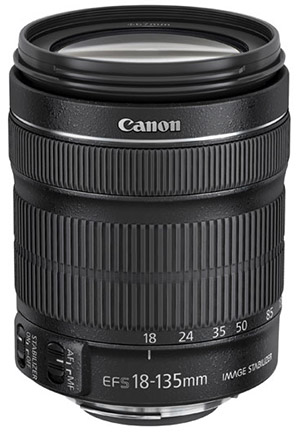
Canon's well proven mid-range wide-to telephoto travel zoom provides a 29-216mm equivalent range on APS-C-format Canon DLSRs, and incorporates one molded aspheric element and two Ultra Low Dispersion (UD) elements, and a 6-group zoom system to maintain consistently high image quality. It uses Canon's IS image stabilization system to provide a 4-stop (16x) advantage in reducing the effects of handheld camera shake at slower shutter speeds, and includes an STM "stepping motor" autofocus drive, plus Dynamic Image Stabilization, resulting in smooth, quiet AF and minimizing the effects of camera motion when shooting video. Other features: a zoom lock to keep the lens from "creeping" to telephoto lengths when the camera is hanging from its neckstrap, and a compact length of less than 4 inches.
Users say:
The majority of hands-on reviews are very favorable, averaging 9 out of 10 points (!), excellent for a lens of this type. Typical comments noted its convenience, compactness, and overall sharpness. As suspected, many owners considered it a great lens for travel and vacations, comparing it favorably to L glass at an attractive price. High marks also went to its smooth zoom action and overall handling characteristics, but some felt its AF is a little slow at times (though our lab tests found it to focus quite quickly).
Bottom line:
If you don't need the super-zoom ratios of the lenses in the first group above, the Canon EF-S 18-135mm is a really excellent choice for a vacation lens. It offers very good imaging performance in its class, in an attractive, compact and high-value package.
Buy Now: $549 -- Amazon • Adorama • B&H
5) Sigma 24-105mm f/4 DG OS HSM ART
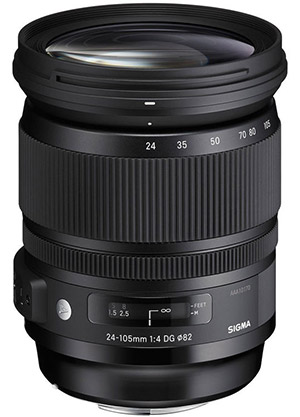
Although this constant-aperture wide-to medium telephoto lens is designed for full-frame cameras, it works quite nicely on APS-C format DSLRs, as well. With the crop factor of a Canon APS-C DSLR, this Sigma lens offers around a 38-168mm-equivalent focal length range. The lens delivers impressive image quality and even illumination over its entire range thanks to an advanced optical design incorporating 3 aspheric, 3 Super Low Dispersion (SLD), and 2 FLD (fluorite equivalent) elements. It has built-in image stabilization to minimize the effects of handheld camera shake, Super Multi-Layer coating on all lens elements to minimize flare and ghosting and enhance contrast, and a Thermally Stable Composite (TSC) is used in the barrel construction to maintain consistently high performance over a wide temperature range. Other features: a rounded 9-bladed diaphragm that yields beautiful bokeh, a Hyper Sonic Motor (HSM) for fast, precise, quiet AF, and a durable high precision brass mount.
Users say:
Reviews by owners are generally very positive, with many considering it as good if not better than the comparable Canon L lens. Owners praised the Sigma's center sharpness as well as its healthy resistance to chromatic aberration and flare, but some had concerns with corner sharpness. The Sigma scored top marks for its solid build quality, great looking design, and built-in image stabilization, although a number of users took issue with its rather hefty weight and lack of weather sealing. Despite the bulk, users overall praised its versatility, stating its usefulness for traveling and being great for scenic and landscape photography.
Bottom line:
A solid addition to Sigma's stellar Art Lens line, it yields impressive results on both full-frame and APS-C Canons in a versatile walk-around focal length range. It's somewhat hefty and a tad pricey, but the pluses far outweigh the minuses.
Buy Now: $899 -- Amazon • Adorama • B&H
6) Canon EF 24-105mm f/3.5-5.6 IS STM
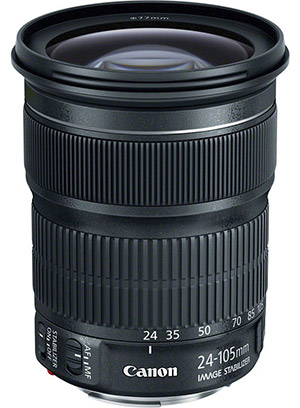
A compact, high performance mid-range zoom for full-frame and APS-C-format Canon DSLRs, offers a more lightweight and less expensive alternative to the 24-105mm f/4L. This variable-aperture version incorporates two aspheric and one ultra-low-dispersion (UD) element and optimized lens coatings to achieve a high level of chromatic aberration correction. It features a stepping STM motor for fast, nearly silent AF, and supports Movie Servo AF to achieve precise focus when shooting video. Other features include built-in optical image stabilization (IS) that provides around a 3-3.5-stop advantage in shake effect reduction when shooting handheld, internal focusing for faster focusing times, and a 7-bladed rounded diaphragm to enhance bokeh.
Users say:
Hands-on reviews by owners are uniformly positive. Owners applaud the excellent image quality and generally lightweight build quality -- though it is bigger and heavier than your typical kit lens. Altogether, these qualities make it a great all-around lens that easy to carry as your main go-to lens.. Even with a variable f/3.5-5.6 aperture range, owners find it bright enough for many low light situations, especially thanks to its image stabilization.
Bottom line:
A good lens for the money, with fast AF, a versatile zoom range, and image stabilization. If you don't need a wider aperture at the telephoto end or comprehensive weather sealing, it should be on your short list.
Buy Now: $599 -- Amazon • Adorama • B&H
Canon L-series telephoto zooms: Superb image quality at attractive prices
These Canon f/4 L long telephoto zooms are more compact and considerably less expensive than their top-tier f/2.8 counterparts, and yet they deliver superb optical performance that's characteristic of their L-series classification. They're not exactly lightweight (the IS version of the 70-200mm f/4L weighs in at 1.67 pounds), but they are reasonably compact and worthy of consideration by anyone that places a premium on top-notch image quality. If you can live without IS or frequently use a tripod, the non-IS version is a phenomenal bargain at a street price of $599 and weighs a tad less -- 1.55 pounds.
7) Canon EF 70-200mm f/4L IS USM
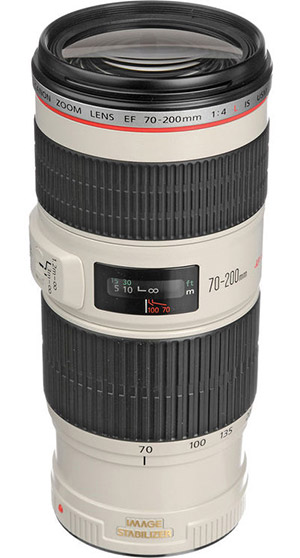
A more compact, lighter f/4 version of Canon's magnificent pro classic, the 70-200mm f/2.8L II, which costs nearly 2 grand, this long telephoto zoom offers imaging performance in a class with single-focal-length lenses. It provides two-mode image stabilization (IS) with a panning option, a fast-focusing ultrasonic AF motor, and pro-caliber build quality at around half the price of the latest f/2.8 version. It incorporates 1 synthetic fluorite and 2 Ultra-Low Dispersion (UD) elements to achieve excellent chromatic aberration correction, is weather sealed, and has a minimum focusing distance of 3.9 feet for capturing impressive close-ups, an 8-bladed rounded diaphragm for enhanced bokeh, and an internal zoom system that delivers fast AF and enables a more compact form factor.
Users say:
Reviews are overwhelmingly positive, with 80% of users giving it a top rating, with the remainder describing it as very good. Top marks go to its relatively small, compact and lightweight design, making it a great alternative to Canon's 70-200mm f/2.8 if you don't need the wider aperture. Of course, praise is heaped on the lens' image quality, with users making such comments as: "great lens, very sharp; much more detailed than those shot with my kit lens; and pro quality at its finest." A minority of negative reviews mentioned a focusing slipping issue, but at least one user pointed out that Canon repaired his lens free of charge under warranty.
Bottom line:
Almost flawless and remains one of the best lenses we've tested. If you can afford it, we do recommend opting for this image stabilized version as it really helps when shooting handheld at long telephoto focal lengths.
Buy Now: $1,099 -- Amazon • Adorama • B&H
8) Canon EF 70-200mm f/4L USM (non-IS version)
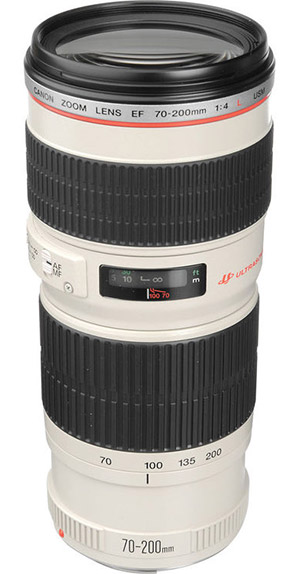
Essentially, this is the same lens as the Canon EF 70-200mm f/4L IS USM described above, except that it doesn't have built-in images stabilization (IS). The optical quality of this lens, like that of its stabilized counterpart, is outstanding, as are its build quality and overall performance. However, Image Stabilization is a very important asset in a moderate-to-long telephoto zoom and for many users, especially those that shoot handheld at long focal lengths and in low light, the IS version may well be worth the difference in price. If you can live without IS, for instance, say you typically shoot with a tripod or handheld in brighter conditions most of the time, then this lens is an incredible bargain.
Users say:
Reviews are overwhelmingly positive with about 80% giving it a top rating and 20% scoring it as 'very good.' Matching our review of the lens, owners note its excellent sharpness. Some point out that the f/4 aperture is perhaps not much a problem if your camera can handle high ISOs, while others do find the lack of stabilization and maximum aperture of just f/4 make it ideal only for well-lit places where capturing action isn't required. Many user reviews note the fast AF and the lens' great build quality. The relatively compact size makes it easy to handhold. Overall, man owners praise the lens as one of the "best bangs for your buck."
Bottom line:
A great lens that's very sharp and well built. It's an amazing bargain, providing you can live without image stabilization.
Buy Now: $599 -- Amazon • Adorama • B&H
• • •
Check out some of our other "Best Of" articles:
9 Great Travel Tripods
Best Tripods For Video
7 Great Tripod Ball Heads
(Index, feature images courtesy of Pexels/Creative Commons Zero license)